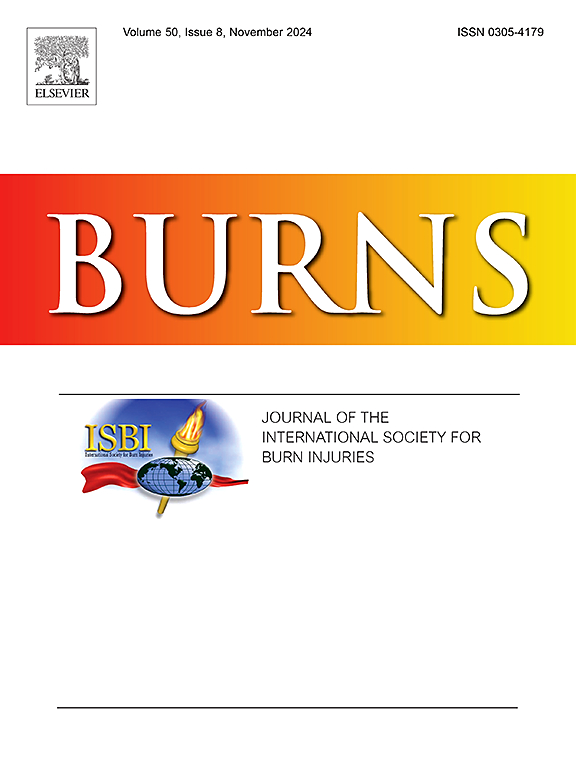暴力烧伤与较低的生活满意度和受伤后失业有关
IF 3.2
3区 医学
Q2 CRITICAL CARE MEDICINE
引用次数: 0
摘要
攻击可能导致暴力烧伤,对幸存者造成深远影响。这些烧伤会导致身体疼痛、心理创伤和就业挑战。在这项研究中,我们的目的是探索与暴力烧伤相关的社会经济人口统计学和纵向社会心理结果。方法纳入1993年至2023年在烧伤模型系统(BMS)数据库中因急性烧伤入院的成年参与者。排除自残烧伤患者。使用描述性统计总结参与者的人口统计数据,并使用Wilcoxon-Mann-Whitney检验和卡方检验比较有意和无意烧伤队列。采用logistic回归模型调查焦虑、抑郁、创伤后应激症状、创伤后成长、就业状况和生活满意度的纵向发生率。结果共纳入4668例患者,其中147例(3.15 %)发生暴力烧伤。与非故意烧伤组相比,故意烧伤组更有可能是黑人(p <; 0.001)、失业(p <; 0.001)、收入较低(p = 0.001)、完成研究生教育的可能性较低(p <; 0.001)。故意烧伤的受试者烧伤面积较大(24.0 vs 16.6 %全身表面积,p <; 0.001)。烧伤后焦虑、抑郁、创伤后成长和创伤后应激与烧伤意向性无显著相关。在控制烧伤总体表面积后,暴力烧伤患者更容易出现失业(p <; 0.001)和较差的生活满意度(p <; 0.001)。暴力、故意烧伤对历史上边缘化和社会经济弱势群体的影响不成比例。这些伤害导致生活质量下降,但对各群体的心理健康没有同等影响。未来的研究应该集中在探索对生活的不满,就业障碍,以及职业咨询在解决这些挑战中的作用。本文章由计算机程序翻译,如有差异,请以英文原文为准。
Violent burns are associated with poorer life satisfaction and unemployment after injury
Background
Assaults can result in violent burn injuries, leading to a profound impact on survivors. These burns can cause physical pain, psychological trauma, and challenges in employment. In this study, we aim to explore socioeconomic demographics and longitudinal psychosocial outcomes associated with violent burns.
Methods
Adult participants admitted for acute burn injury between 1993 and 2023 within the Burn Model System (BMS) database were included in the study. Patients with self-inflicted burn injuries were excluded. Participant demographics were summarized using descriptive statistics and compared between the intentional and unintentional burn cohorts with Wilcoxon-Mann-Whitney and Chi-square tests. A logistic regression model was constructed to investigate longitudinal occurrences of anxiety, depression, and posttraumatic stress symptoms, posttraumatic growth, employment status, and satisfaction with life.
Results
A total of 4668 patients were included in the study, of whom 147 (3.15 %) sustained violent burns. The intentional burn cohort was more likely to be Black (p < 0.001), unemployed (p < 0.001), have lower income (p = 0.001), and less likely to have completed graduate education (p < 0.001) than the unintentional burn cohort. Participants with intentional burn injuries had larger burns (24.0 vs. 16.6 % total body surface area, p < 0.001). Post-burn anxiety, depression, post-traumatic growth, and post-traumatic stress were not significantly associated with burn intentionality. After controlling for burn total body surface area, patients with violent burns were more likely to experience unemployment (p < 0.001) and poorer satisfaction with life (p < 0.001) after injury.
Conclusions
Violent, intentional burn injuries disproportionately impact historically marginalized and socioeconomically disadvantaged individuals. These injuries lead to poorer quality of life without an equivalent impact on psychological health across groups. Future research should focus on exploring dissatisfaction with life, barriers to employment, and the role of vocational counseling in addressing these challenges within this patient population.
求助全文
通过发布文献求助,成功后即可免费获取论文全文。
去求助
来源期刊

Burns
医学-皮肤病学
CiteScore
4.50
自引率
18.50%
发文量
304
审稿时长
72 days
期刊介绍:
Burns aims to foster the exchange of information among all engaged in preventing and treating the effects of burns. The journal focuses on clinical, scientific and social aspects of these injuries and covers the prevention of the injury, the epidemiology of such injuries and all aspects of treatment including development of new techniques and technologies and verification of existing ones. Regular features include clinical and scientific papers, state of the art reviews and descriptions of burn-care in practice.
Topics covered by Burns include: the effects of smoke on man and animals, their tissues and cells; the responses to and treatment of patients and animals with chemical injuries to the skin; the biological and clinical effects of cold injuries; surgical techniques which are, or may be relevant to the treatment of burned patients during the acute or reconstructive phase following injury; well controlled laboratory studies of the effectiveness of anti-microbial agents on infection and new materials on scarring and healing; inflammatory responses to injury, effectiveness of related agents and other compounds used to modify the physiological and cellular responses to the injury; experimental studies of burns and the outcome of burn wound healing; regenerative medicine concerning the skin.
 求助内容:
求助内容: 应助结果提醒方式:
应助结果提醒方式:


